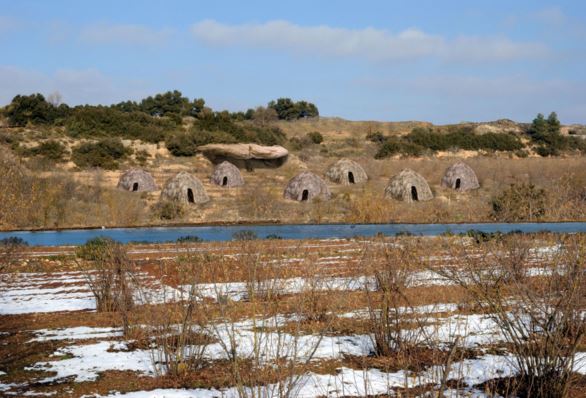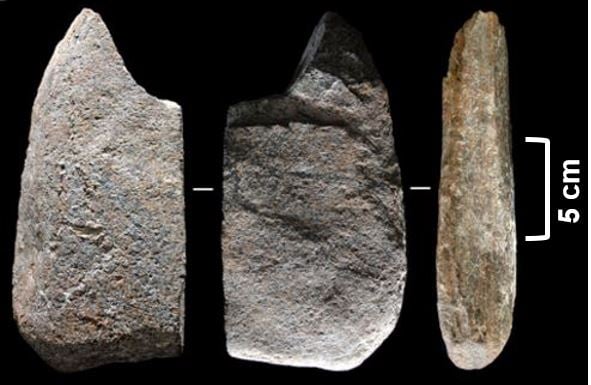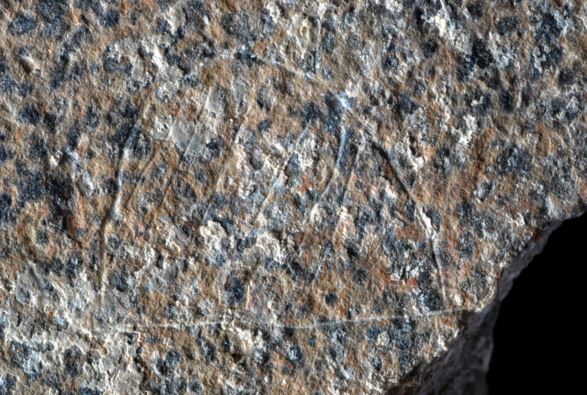Scientists have discovered fascinating prehistoric rock carvings that depicted hunter-gatherer campsites 13,800 years ago. The archaeologists, from the University of the Basque Country and the Catalan Institute of Human Paleoecology and Social Evolution (IPHES), both in Spain, believe the Paleolithic engraving, discovered in northeastern Spain “brings us the first representation of a human social group.”
Hunter-gatherers formed part of early human society in which most or all of their food was obtained from wild plants and animals, in contrast with farming societies, which rely mainly on crops and domesticated species. Hunting and gathering dominated human lifestyles until about 10,000 years ago.
Manuel Vaquero, from the Catalan Institute and colleagues wrote about their study in the open-access journal PLoS ONE.
 A virtual reconstruction of the hunter-gatherer campsite that the prehistoric carvings depicted. (Image: University of the Basque Country. Credit: Luis Alberto Marcos)
A virtual reconstruction of the hunter-gatherer campsite that the prehistoric carvings depicted. (Image: University of the Basque Country. Credit: Luis Alberto Marcos)
Peleolithic art findings very rarely include depictions of landscapes and the everyday world, the authors wrote. The Paleolithic Era was a period from 2.6 million years ago until the end of the Pleistocene about 10,000 BP.
Vaquero and colleagues analyzed the morphology (shape) of an engraved schist slab that had recently been discovered in the Molí del Salt site in Catalonia, northeastern Spain, dated approximately 13,800 years ago, i.e. towards the end of the Upper Paleolithic period.
Seven motifs probably depicted huts
The schist slab contained seven engraved decorative designs (motifs) with internal lines arranged in a pair of rows.
After examining the motifs’ proportions and morphology, the scientists concluded that they were designed to represent huts. Microscopic and comparative analyses indicated that all the motifs were engraved using a similar technique over a very short period of time.
After analyzing each motif individually, including their composition and archaeological and ethnographic contextualization, the research team believes the engraving represents hunter-gatherer campsites.
Mr. Vaquero and Marcos García-Diez, from University of the Basque Country, say the engraving could be one of the first representations of social and domestic space of a human group.
 The engraved schist slab from Molí del Salt. (Image: PLOS ONE)
The engraved schist slab from Molí del Salt. (Image: PLOS ONE)
The authors concluded in an Abstract in the journal:
“Campsites can be considered the first human landscape, the first area of land whose visible features were entirely constructed by humans.”
“Given the social meaning of campsites in hunter-gatherer life-styles, this engraving may be considered one of the first representations of the domestic and social space of a human group.”
According to the University of the Basque Country, the first excavation campaign in El Molí del Salt occurred in 1999. These excavations have continued, virtually non-stop since then.
 A close-up photo of a motif. (Image: Eurekalert. Credit: García-Diez et al)
A close-up photo of a motif. (Image: Eurekalert. Credit: García-Diez et al)
The study was supported by the Generalitat de Catalunya, the municipality of Vimbodí i Poblet (Tarragona), the Consell Comarcal de la Conca de Barberà, and SOREA (a Catalonian water-supply company).
Reference: Citation: Marcos García-Diez and Manuel Vaquero. “Looking at the Camp: Paleolithic Depiction of a Hunter-Gatherer Campsite.” PLOS ONE. December 2, 2015. DOI: 10.1371/journal.pone.0143002.
